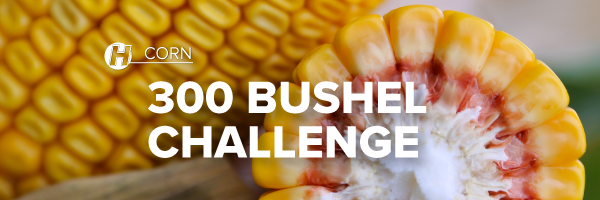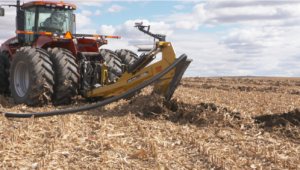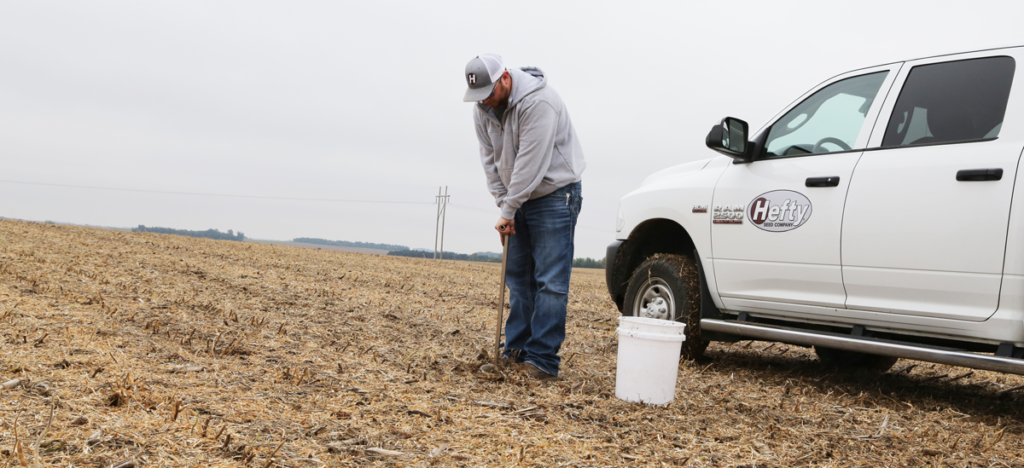By Brian Hefty

By Brian Hefty
When Darren and I were putting things together for this month’s magazine, he wrote down, “Brian – 300 bushel challenge – Here’s what I’m doing to hit 300 this year on my farm, I challenge you do go for it on some of your acres, as well”.
I love the topic, but please understand, every farm is different. The things we need to change may or may not be different from your farm. We have raised 300-bushel corn before, but just in plots or in spots of fields, never on a whole field average. That is my goal this year, and here is how I intend to get there.
TILE

Adequate drainage is the first step to achieving ideal balance in your soil. Installing tile can help.
We have now tiled almost every field we farm. This is a must if you want long-term high yields and good profits in our region. Without adequate air, soil life and crop roots will die.
SOIL FERTILITY
Here could be the biggest difference from our farm to yours. Our soil is mostly heavy. Our temperatures are cold (the ground is frozen almost half the year), and we are usually quite dry (20-22 total inches of precipitation annually). In other words, we can’t move nutrients well in soil at all. Even the leachables (N, S, and B) don’t leach much. Sidedressing is less consistent than in almost any other corn-growing area. Early applications and building soil levels are a key to success here. If you have light soil in a warm climate with lots of rain and irrigation, this changes everything. Here is what I want for soil test levels before the start of the season on our farm, and if I have these, I am 100% confident the fertility in the soil plus what I apply will be more than adequate for 300, if not even 400-bushel corn.

Before you can make applications of required fertility, you need to pull samples to get to know your ground. We recommend sampling one-acre grids to get the most complete picture of your fields.
This year we are applying 200 pounds of ammonium sulfate in the spring, because we were short on sulfur on a lot of our fields. We also sprayed a lot of liquid 28% with our herbicide this spring to get our early, available, total nitrogen up near 150 to 200 pounds. Again, this isn’t a good plan in light soils with lots of moisture, but in our heavy ground with little rain, it’s fine. We will sidedress nitrogen if our pre-sidedress nitrate tests show we need more.
STARTER FERTILIZER
Even though we will either have good soil test levels or apply a lot of fertility in the strip or broadcast, we still love starter fertilizer. In-furrow, we usually keep the rates pretty low, but we use Pro-Germinator, Sure-K, and Micro 1000 from AgroLiquid. In a 2 X 2, and especially where we have the 2 X 2 on both sides of the row on our research planters, we will bump the rate a little bit more.
CORN VARIETY
We will probably plant over a dozen corn hybrids on almost 2000 acres of corn. It will all be Hefty Brand Corn for 3 reasons. First, our genetics are as good or better than any other company’s. The selection process is what Darren spends the vast majority of his time on, and he does a great job. Who else would you rather trust when it comes to picking hybrids? Second, our seed treatment is leaps and bounds better than any other company’s. Our corn seed usually pops out of the ground 10% to 20% faster than any other company’s, and that’s due to the seed treatment. Plus, we usually see better early growth, healthier plants, fewer seed & seedling diseases, thicker stands, and ultimately, more yield due to the seed treatment. Finally, our cold germination scores have been better than other company’s in our testing. We have to have great cold germ when planting in our region most years. If we are able to plant early (mid-April), I would prefer to raise a 105-day corn or later to maximize yield potential. We will run VT2P in most of our fields. In terms of population, we’ve hit 300 at 34,000 plants per acre before, so we will likely stay at 34,000 on the majority of our high yield ground, but we’ll raise that to 37,000 and even 40,000 in some areas to see if those high populations turn out better than they have in the past. Increasing population to those levels has typically hurt our yield.
HERBICIDE
There are lots of great options, and rather than get product specific, I will just tell you we are big believers in getting a Group 15 herbicide (Harness, Surpass, Outlook, Dual, Zidua, etc.) out before tillage or sprayed before emergence in strip-till. Post-emerge, we like using an HPPD herbicide (Laudis, Callisto, Impact, Armezon, etc.) along with Roundup. Even though it slightly hurts the performance of the Roundup, we occasionally throw in some atrazine post-emerge. We use Status instead of the HPPD in fields with super-bad weed pressure, which we fortunately don’t have much of anymore.
OTHER STEPS
We spent a lot of time and money working on our planter this spring, and we will definitely need to do a good job of making sure our seeds are planted at a consistent depth (I like 2” to 2.25”) and at an even spacing from plant to plant. Our rural water is chlorinated and high in pH, so we typically use Bio-Prep and Water-Rite for pennies an acre to make sure the water is adjusted for best performance when spraying almost anything. From emergence until mid-August, we will tissue sample in a couple spots in each field where we are shooting for real high yields. We can always sidedress or foliar feed. Tentatively, I plan to add some Ferti-Rain and AC-97 foliar fertilizers along with Nutex EDA at some point during the season. We will definitely spray a fungicide around the V8 timing, and we may add another shot of fungicide at silking if the year ends up being wet and humid. In terms of insecticide, we will at least put some Capture LFR in-furrow, but we may go with Temitry LFR (Capture LFR plus Headline) if planting real early. Post-emerge, we may spray insecticide at any point we see a lot of harmful insects. We will also continue experimenting with N-Hydro trying to fix some nitrogen in plants and Boost 10, which contains amino acids. Finally, it’s going to take some scouting and adjustments in-season to get to our goal of 300, as well as lots of prayers for good weather, but I hope we can do it, and I hope you can, too!
All soil test levels are based on Midwest Labs’ tests and extraction methods, so make the conversion if you are using other tests and different labs.
- pH = 6.3 to 6.8
- Calcium = over 65%
- P1 Phosphorus = 100+ ppm
- Base Saturation K = 7%+
- Potassium ppm = 500+, but I prefer 700+. Keep in mind, our K doesn’t leach in heavy, cold, dry soil.
- Sulfur = 50+ ppm
- Zinc = 10+ ppm
- Copper = 2+ ppm
- Molybdenum = 1 ppm
- Iron = 20+ ppm (we are always good on iron, it seems like)
- Boron = I’m not really sure on this, because I haven’t found what I consider ideal. I think we may have to be over 5 ppm, because at 2 ppm we are still deficient in plant tissue analysis. Be very careful with boron, because if you get too much in the wrong place at the wrong time, it can be very detrimental. We certainly haven’t experienced that, so we keep adding more.
- Manganese = With this one I can’t give you a good answer at all. For years we’ve said we want to see more than 20 ppm on a Midwest Labs’ DTPA test, but our yield data is inconclusive on this. In other words, higher levels aren’t always translating to higher yields. We will continue to work on this and give you more information as we figure it out in working with hundreds of farms across the country.
Fertility Required
We will vary our applications a lot if we aren’t at the soil test levels you see above, but I want you to keep this in mind. Big crops have big nutrient needs. From the Ag PhD Fertilizer Removal App, here is what 300-bushel corn requires:
- Nitrogen – 336 pounds – this can come from what’s already in the soil, what mineralizes from organic matter (if we have 4% O.M. we figure about 80 to 100 pounds), and what we apply
- Phosphate – 153 pounds
- K2O Potassium – 405 pounds
- Sulfur – 45 pounds
- Manganese – 2.47 pounds
- Zinc – 0.77 pounds
- Boron – 0.8 pounds

